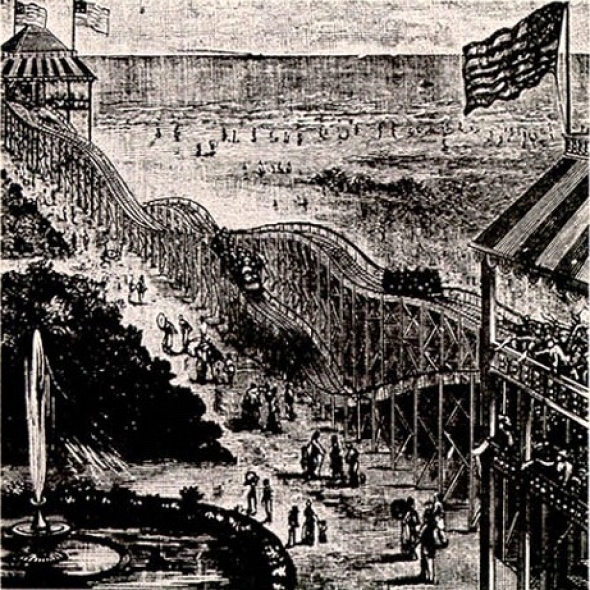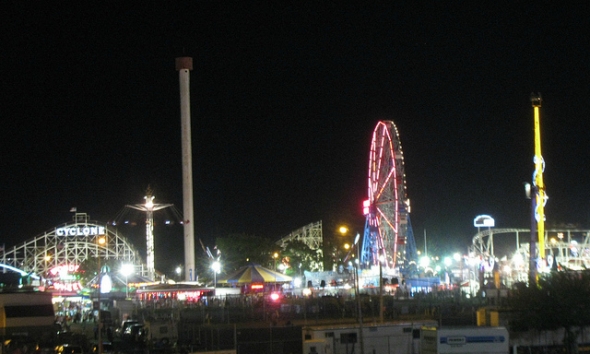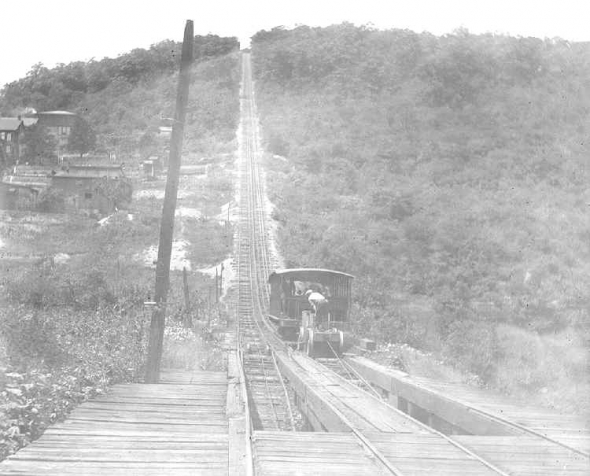Fathering the modern roller coaster
Image: Disney
Imagine Thompson’s excitement when he reached Mauch Chunk. His life’s work was no longer possible, and he was actively seeking new inspiration. There, in a coal miner’s town, he stumbled across a nascent technology brimming with possibilities. A man of science and invention, he quickly deduced that this idea would prove even more popular in a larger metropolitan area. All he needed to do was find a way to craft a man-made mountain in a small space.
While the name is misspelled on the patent, you can take a look at what he invented right here. You’ll want to turn the first image sideways to make sense of it. What you’re studying is the world’s first (or, at the very least, most important) roller coaster patent. His application begins thusly:
“Be it known that I, LA MARoUs A. THOMP- soN, of South Chicago, county of Cook, and State of Illinois, have invented certain new and useful Improvements in a Roller Coasting Structure, of which the fol-lowing is a full. clear, and exact description, that will enable others to make and use the same, reference being had to the accompanying drawings-forming a part of this specification.
“This invention relates to an improved coast ing structure to be used as a means of pleasure and-amusement; and it consists of certain novel featuresin the construction and arrangement, as will be hereinafter more fully set forth and claimed.” (sic)
Image: Wikimedia Commons (license)
He closes the application with the most important details:
“Having thus described my invention, what I claim as new, and desire to secure by Letters Patent, is-
“1. In a coasting structure, the combination, with the tracks B B, running parallel with each other and having the starting and terminal stations at the same elevation, of the switch-tracks E F, whereby the car reaching the terminus on the outgoing track is transing trest1e-w0rk C and the platform (1 and ferred to the return-track and back again to d of the same height, substantially as de the first track for another trip, substantially scribed. as described.
“2. In a coasting structure, the combination, with two parallel tracks or road-beds having undulating grades or planes, of the support LA MARCUS A. THOMPSON. \Vitn esses:”
What you can draw from this information is that A) a master inventor of hosiery machines and roller coasters doesn’t bother to master spelling and punctuation and B) Thompson was so confident in the originality of his man-made structure that he patented it to prevent copycats from benefiting from his sweat of brow.
That leads to an important caveat. A gentleman named John G. Taylor also patented something that could be loosely described as roller coaster technology in 1872. The Baltimore resident also earned one patent for his work, but he never received the same credit as Thompson. That’s presumably because Thompson wound up with roughly 30 patents related to roller coasters, as he constantly sought to perfect the process. Meanwhile, Taylor only gained a single one, patent 128,674, which was for an “Improvement in inclined railways.” Engineers who have studied Taylor’s patent vs. those of Thompson rightfully consider what Thompson did critical to the modern roller coaster.
The other key aspect of the conversation is that no confirmed evidence exists that Taylor ever built the coaster for which he received a patent. Some Baltimore newspapers reference it, but the only picture of something that could qualify lacks a confirmation date. It’s entirely possible that Taylor built a coaster that precedes the famous one at Coney Island by a decade or more. There’s just no evidence of it. That’s why Taylor is anecdote in discussions of roller coaster history while Thompson is revered as the founding father of the industry.
Welcome to Coney Island!
Image: edenpictures, Flickr (license)
1884 was the most important year for roller coaster innovation prior to the opening of Disneyland. That year, Thompson unveiled the Gravity Pleasure Switchback Railway at Coney Island. It was an immediate blockbuster success. Part of the explanation was location. While Coney Island only claims a population of 25,000 even today, it is readily accessible from all boroughs of New York City. Even during the 1880s, 1.2 million people lived in the city. It was already the most populous one in the United States. Putting the world’s first roller coaster nearby was one of the best business moves in the history of amusement parks.
While eastern Pennsylvania coal mining towns don’t have a lot of national status, a ride like the Switchback Railway at Coney Island immediately garners international headlines. The 19th century equivalent of theme park tourists flocked to this new sensation, paying a nickel a ride. Thompson once reported that he earned $600 daily during the early years of the Switchback Railway. That’s the equivalent of $14,634 today. The marvel here is that at a nickel a ride, we’re discussing 12,000 customers per day. And this wasn’t a ride that had the massive throughput you’d see at a theme park attraction today. The demand for the Switchback Railway was off the charts.
Thompson had followed up his success in the hosiery industry with what we’d now describe as a five million dollar annual revenue stream. From a single ride. Soon afterward, the inventor began duplicating his coaster track at other locations across the country. Within four years, 50 different Switchback Railways existed. He understood that competitors were quickly copying his lucrative idea. By building his own constructs, he could ward off imitators before they gained a foothold in the coaster industry he effectively created. In addition to being the Father of the Roller Coaster, Thompson also possessed business acumen on a par with Walt Disney. The two men were kindred spirits separated by two generations.
What made the Switchback Railway so innovative? That’s the critical part of this discussion. We’ve learned how ice slopes turned into railways and how sleds turned into roller coaster carts. The parallel from Russian Mountains to the Switchback Railway goes beyond these terms, though. Thompson used the premise as a baseline for his attempt. He built a pair of symmetrical courses next to one another. From a side view, they wouldn’t look the same since the start of one was the end of the other and vice versa. They were structurally identical, though.
Image: Wikimedia Commons (license)
Where his concept differentiated itself from Russian Mountains was in the addition of hills. You know them today as air-time, but that’s a comically extravagant description of what the Switchback Railway offered. We’re talking about a very slight raise in elevation before an almost immediate decline. It’s like when your car travels over a hill. You go up and then down almost instantly. This bit of non-linear riding qualified as a major breakthrough in the 19th century.
The speed of the Switchback Railway was so mild that you likely jog faster. It went six miles per hour for roughly 600 feet. The start of the ride began 50 feet in the air, requiring another ladder climb to get to the coaster cart. Again, it was similar to the Russian Mountains save for the fact that all motion was man-made rather than ice-based. He constructed a roller coaster cart on wheels that rode the track layout to the bottom then circled around, the switchback part of the railway.
Since the earliest known roller coaster didn’t require ice, it could operate all year, differentiating it from Russian Mountains. It also didn’t need an additional incline to move like the sled-based iterations of the concept. While it was a gravity ride in both design and name, the Switchback Railway was the first coaster of its kind to deliver a guided trip. The tracks determined the course, and the wheels kept the cart on the path. It was in all ways what we have come to consider a roller coaster, which is why Americans have a good claim as the originators of the modern version.
Since Thompson so carefully mimicked the themes and ideas of Russian Mountains, however, they too have a valid claim. Without their ideas – and the support of Catherine the Great – the Father of the Roller Coaster never would have built the Switchback Railway. Then again, just to mess with your head a bit, the Russian phrase for roller coaster translates as American Mountains, so the terms the countries use seem stubbornly chosen to cause the highest level of confusion.





Add new comment